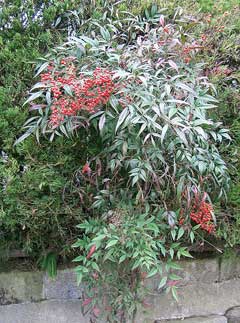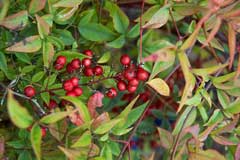 |
|
http://commons.wikimedia.org/wiki/User:KENPEI |
 |
|
Translate this page:
Summary
Bloom Color: White. Main Bloom Time: Early spring, Late spring, Mid spring. Form: Upright or erect.
Physical Characteristics

 Nandina_domestica is an evergreen Shrub growing to 2.5 m (8ft) by 2 m (6ft) at a medium rate.
Nandina_domestica is an evergreen Shrub growing to 2.5 m (8ft) by 2 m (6ft) at a medium rate.
See above for USDA hardiness. It is hardy to UK zone 7 and is not frost tender. It is in leaf all year, in flower from June to July. The species is hermaphrodite (has both male and female organs).
Suitable for: light (sandy), medium (loamy) and heavy (clay) soils and prefers well-drained soil. Suitable pH: mildly acid, neutral and basic (mildly alkaline) soils. It cannot grow in the shade. It prefers moist soil.
UK Hardiness Map
US Hardiness Map
Synonyms
Plant Habitats
Edible Uses
Fruit[2]. No further details are given, but another report says that the fruit is poisonous[147]. The fruit is about 10mm in diameter[200]. Young leaves - boiled[177]. The water must be changed at least once during the cooking[105].
References More on Edible Uses
Medicinal Uses
Plants For A Future can not take any responsibility for any adverse effects from the use of plants. Always seek advice from a professional before using a plant medicinally.
The roots and stems are antitussive, astringent, febrifuge, stomachic and tonic[147, 174]. A decoction is used in the treatment of fever in influenza, acute bronchitis, whooping cough, indigestion, acute gastro-enteritis, tooth abscess, pain in the bones and muscles and traumatic injuries[147]. It is especially useful in the treatment of children's coughs[174]. There is a danger that an overdose can cause respiratory paralysis[174]. A decoction of the leaves is tonic[218]. The fruit is febrifuge and tonic[218]. Another report says that it is toxic, so great care should be employed if using it[147]. The root is antirheumatic[218]. Young shoots contain high concentrations of laetrile - up to 20% on a zero moisture basis[218].
References More on Medicinal Uses
The Bookshop: Edible Plant Books
Our Latest books on Perennial Plants For Food Forests and Permaculture Gardens in paperback or digital formats.

Edible Tropical Plants
Food Forest Plants for Hotter Conditions: 250+ Plants For Tropical Food Forests & Permaculture Gardens.
More

Edible Temperate Plants
Plants for Your Food Forest: 500 Plants for Temperate Food Forests & Permaculture Gardens.
More

More Books
PFAF have eight books available in paperback and digital formats. Browse the shop for more information.
Shop Now
Other Uses
Plants are used for hedging in warm temperate zones[200].
Special Uses
References More on Other Uses
Cultivation details
Landscape Uses:Border, Container, Foundation, Massing, Rock garden, Screen, Specimen. Requires a deep rich moist soil in a sheltered sunny position[11, 200]. Prefers a cool but sunny position[200]. A very ornamental plant, it only successful outdoors in Britain in favoured localities[1]. Grows well in Cornwall[59]. Tender when young[11], the shoot tips of mature plants can be damaged by hard frosts[200]. A number of named forms have been developed for their ornamental value[182]. Untidy old stems on established plants can be pruned to the base in spring[188]. Cultivated for its fruit in China and Japan[2] ( does this refer to medicinal usage?). It does not fruit freely in Britain[11]. Plants in this genus are notably resistant to honey fungus[200]. Special Features:
Attracts birds, Attractive foliage, Not North American native, Invasive, Naturalizing, Attractive flowers or blooms.
References Carbon Farming Information and Carbon Sequestration Information
Temperature Converter
Type a value in the Celsius field to convert the value to Fahrenheit:
Fahrenheit:
The PFAF Bookshop
Plants For A Future have a number of books available in paperback and digital form. Book titles include Edible Plants, Edible Perennials, Edible Trees,Edible Shrubs, Woodland Gardening, and Temperate Food Forest Plants. Our new book is Food Forest Plants For Hotter Conditions (Tropical and Sub-Tropical).
Shop Now
Plant Propagation
Seed - best sown as soon as it is ripe in a greenhouse[113]. Stored seed should be sown as early in the year as possible in a greenhouse. Germination is often poor[200]. When they are large enough to handle, prick the seedlings out into individual pots and grow them on in the greenhouse for at least their first winter. Plant them out into their permanent positions in late spring or early summer, after the last expected frosts. Cuttings of half-ripe wood 10 - 15cm long, July/August in a frame[78]. Pot up in the autumn and overwinter in a cold frame. Plant out in late spring. High percentage[78] but very slow[11]. Cuttings of mature wood, 10 - 15cm with a heel, November in a frame[78]. Plant out the following autumn[78, 200]. High percentage[78] but very slow[11].
Other Names
If available other names are mentioned here
Native Range
TEMPERATE ASIA: China, Japan (Honshu, Kyushu, Shikoku)
Weed Potential
Right plant wrong place. We are currently updating this section.
Please note that a plant may be invasive in one area but may not in your area so it’s worth checking.
Conservation Status
IUCN Red List of Threatened Plants Status :

Growth: S = slow M = medium F = fast. Soil: L = light (sandy) M = medium H = heavy (clay). pH: A = acid N = neutral B = basic (alkaline). Shade: F = full shade S = semi-shade N = no shade. Moisture: D = dry M = Moist We = wet Wa = water.
Expert comment
Author
Thunb.
Botanical References
1158200
Links / References
For a list of references used on this page please go here
Readers comment